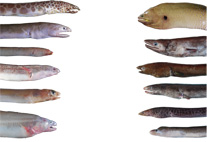Abstract
A new worm eel (Ophichthidae, Myrophinae), Muraenichthys velinasalis, is described based on five specimens (97.9–281.0 mm of total length) collected from Taiwan, Philippines, northeastern Australia, Vanuatu, and Sri Lanka. Muranichthys velinasalis is most similar to M. philippinensis and M. schultzei in the position of the dorsal-fin origin behind a vertical through mid-anus, but can be easily distinguished from the latter two species by the condition of the posterior nostril, unique character of M. velinasalis within Muraenichthys, and by the shape of the teeth on the innermost row of the upper jaw (relatively robust and slightly pointed vs. slender and pointed), arrangement of upper-jaw teeth (irregularly biserial anteriorly and uniserial posteriorly vs. completely uniserial in M. philippinensis, biserial or triserial in M. schultzei), and its more numerous or fewer preanal and total vertebrae (44–51 vs. 59–60 in M. philippinensis, 42–47 in M. schultzei; 136–139 vs. 128–130 in M. philippinensis, 119–128 in M. schultzei). The genus Muraenichthys is re-defined based on all currently valid species by the following combination of characters: eyes located anterior to mid-jaw; inner hole of posterior nostril above upper lip, and outer hole usually outside of mouth, with a prominent but short projected flap anteriorly; a single pore between anterior and posterior nostrils; three preopercular pores; teeth on jaws, vomer, and intermaxillary area; tooth shape variable, blunt to pointed but not distinctly recurved and tooth length equal or less than a half of eye diameter; teeth on jaws and vomer arranged in one to five rows; gill opening constricted, its height<170% of eye diameter; pectoral fins absent.

